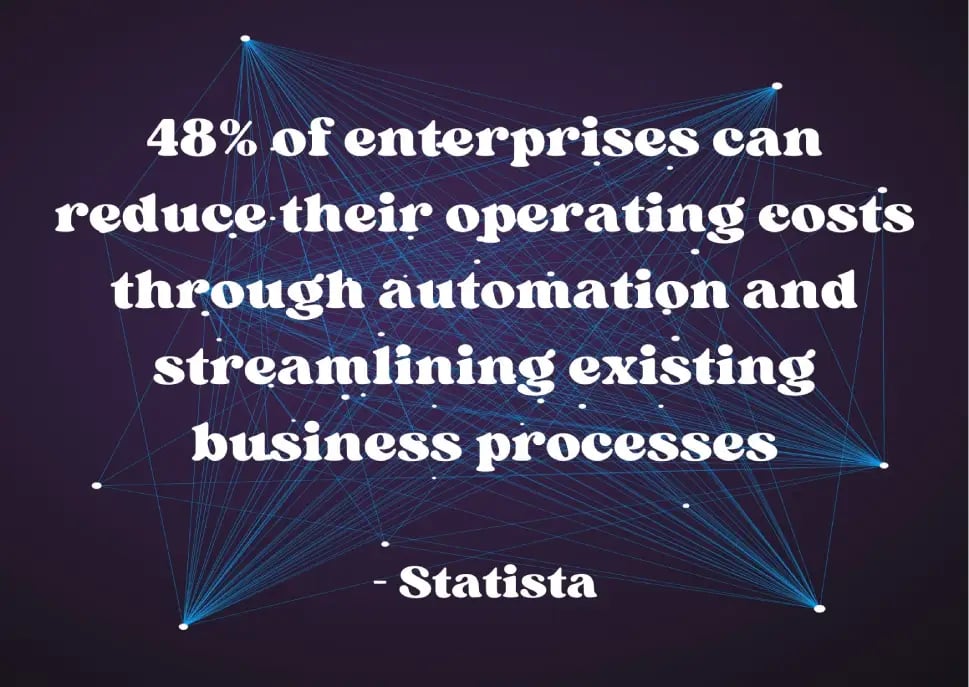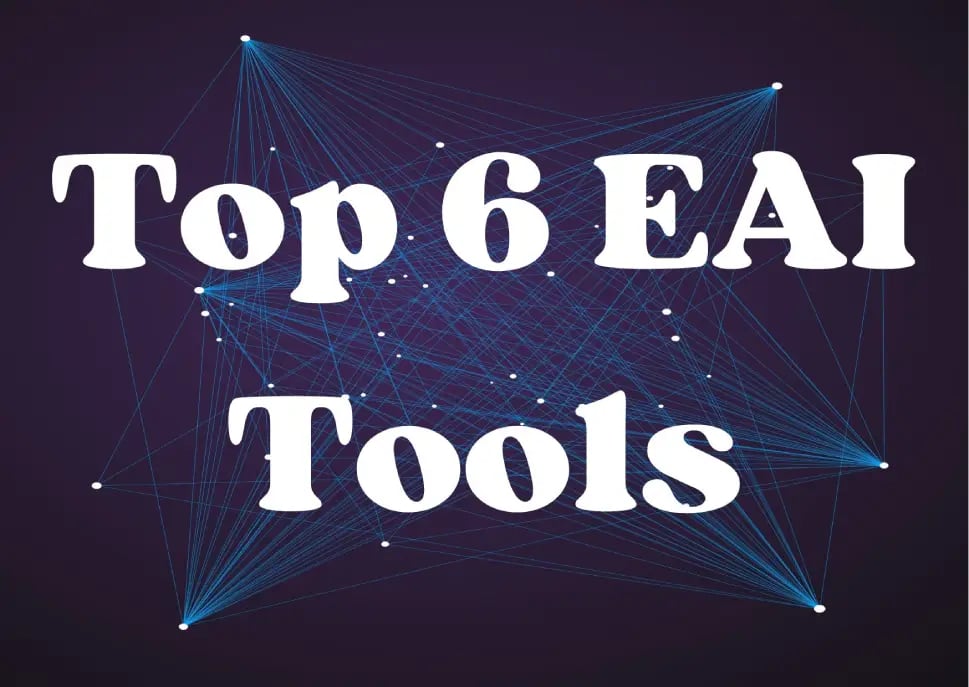
What is enterprise application integration? In this article, we look at best practices, examples, tools, software, and various EAI solutions.

Enterprise Application Integration Explained
What Is Enterprise Application Integration?
Benefits, Examples, and Alternatives?
Businesses, particularly those that have been around for a long time, are like a finely-tuned and slightly temperamental clock. They have lots of moving parts, which work together in harmony, performing different functions. Rarely, if ever, do they sputter to a halt.
However, sometimes new elements are introduced to a company, such as new software. This can throw everything off kilter if it isn’t integrated with existing tools. These software tools need to be able to communicate with each other for optimum efficiency to avoid mistakes, duplications, and wasted time and effort.
In this article, we’re going to take a look at how businesses can ensure their software tools communicate effectively with each other.
What is enterprise application integration (EAI)?

The job of enterprise application integration tools is to integrate the different software in a company so it can communicate as part of a streamlined process.
But how do they do that? These tools, provided by iPaaS or ESB solutions businesses, act as conduits between applications, establishing a middleware framework that allows data to move between different software.
Put simply, EAI integrates applications with the operating systems they run on, whether that’s Microsoft Windows, macOS, or anything in between.
Enterprise application integration examples
Let’s now look at some examples of enterprise application integration architecture. Bear in mind here that some industry experts already see EAI as obsolete and are switching to other approaches. That said, it’s still widely in use and so worth discussing in this article.
SOA (service-oriented architecture)
SOA (service-oriented architecture) is a way to make software components reusable through service interfaces. A common interface standard and architectural pattern are used so they can be integrated into new applications.
In an SOA, every service carries out the code and data integration needed to perform an enterprise function. The service interface provides loose coupling, which limits dependencies between apps.
Applications behind the service interface can be written in any programming language. The services are exposed using standard network protocols to send requests to read or change data.
These services are eventually published in a registry, so developers can easily find and reuse them to create new business applications or processes.
EDA (event-driven architecture)
EDAs (event-driven architectures) are asynchronous-based. This allows data to be processed quickly, with minimally coupled and decoupled components that can manage events across cloud and containerized environments. This reduces the risk of failure.
EDAs capture and process events dynamically to make real-time decisions and construct responsive applications.
Event-driven architecture consists of event producers and event consumers. An event producer detects an event and represents this as a message. After it’s been detected, it’s transmitted through event channels between the producer and event consumers. There, an event-processing platform will process it asynchronously.
Monolithic architectures

Monolithic architectures are best suited to simple applications that are packaged and deployed as single processing units. The software components in these architectures are tightly coupled. In other words, each component depends on the other completely. This means that when simple applications grow over time, they can become complex and start presenting limitations.
While monolithic architectures are simple, easy to develop and deploy, and enjoy optimized response times, they struggle with a larger code base and can become overloaded, which has a knock-on effect on productivity.
The difference between iPaaS and ESB approaches
Before we go any further, it’s worth clarifying the differences between iPaaS and ESB approaches. While both fall under the umbrella of enterprise application integration, an iPaaS generally runs in the cloud and is designed to handle integrations between SaaS solutions and cloud services. ESBs, on the other hand, operate on-premise and integrate apps with local or legacy systems.
The benefits of enterprise application integration
There are several EAI benefits, the most important of which are discussed below.
Reduced cost
Using EAI technologies is one way to reduce a company’s costs. Time equals money, and fewer employee hours are wasted if you can avoid duplicating work by using hybrid integration solutions.
Another example is the integration of new software with older software. Instead of removing old software and replacing it with a newer version, you integrate the two to avoid losing/wasting the money spent on your previous investment.
You can also use EAI middleware to come up with fresh solutions to old problems and develop new and cost-effective ways of doing things. Remember, the more streamlined your work is, the more money you save.

Improved productivity
If you spend an hour juggling multiple software tools, you’re naturally going to be less productive than if you have one interface that connects these software solutions. Instead of frittering away at different tools, you can spend the time saved on more productive work.
By increasing speed and ease, enterprise application integration solutions increase productivity i.e. by using hybrid integration.
The increased information exchange capability means everyone in your office will also have access to the same datasets, and these will be updated and corrected automatically across different software via your EAI tool. This is great for productivity.
Enhanced management and data sharing
As we mentioned, EAI allows for the easy flow of data between different software tools within your enterprise, as well as from third parties to your computer systems.
Enterprise application integration can help streamline and consolidate your data collection work, removing the duplication that occurs when you have each application collecting and storing data separately.
EAI also offers a single access point for data, meaning your staff waste less of their working hours searching for information. What’s more, the data they’ll find will be up-to-date and complete as a result of removing duplications.
This improved data management and sharing make cross-collaboration between departments easier, improving team working efforts.
Workflow automation
Enterprise application integration can streamline the processes in your workflow that include activity or data from different software tools.
By taking information from one tool and using it to feed the process of another, you can create a seamless series of events and automate the transfer of data.
This means you won’t have to manually input data from one tool into another, helping avoid input errors while saving time.
Simplified IT processes
Enterprise application integration overcomes the very real problem of companies struggling to use new technology correctly and to its maximum potential. Certainly, it can be difficult to train everyone and help them wrap their heads around a new system.
EAI makes this a smooth and easy process by integrating the data and functionality of multiple applications into one user-friendly interface. This means your colleagues only need to learn how to use a single tool rather than feeling pulled at from all angles as they struggle to use one application after the next.
This saves both time and money in terms of training hours and also time wasted on struggling with a difficult system.
More opportunities
With the help of enterprise application integration platforms, you can give your enterprise a competitive edge and more opportunities compared to companies in your field that aren’t deploying EAI middleware.
Having a robust IT environment with integrated software solutions and a platform that’s easy to understand and navigate will give your team an advantage. This is the foundation of a successful digital enterprise in this day and age.
Applying EAI solutions improves your team’s ability to resolve common problems and increase production. You can use these for your entire software environment, enhancing everything from accounting to marketing and giving you a streamlined and aggressive edge.
The best enterprise application integration software and tools (as well as some top-tier alternatives)

While there’s a wealth of EAI tools to choose between, we’ve rounded up some of our favorites below.
You’ll note not all of these fit neatly beneath the umbrella of EAI. That’s because, as we briefly discussed above, EAI is a double-edged sword i.e. it’s useful but also rapidly becoming outdated. As a result, increasing numbers of companies are looking into API and microservices-based alternatives.
1. OpenLegacy
OpenLegacy (and our OpenLegacy Hub) is one of the newer heavy hitters on the market, offering an EAI alternative with a digital assets repository powered by continuous, automated, test-driven development via CLI.
We offer fully reusable modules, automated templating, and built-in cloud native deployment, as well as flexible digital service creation, with no-code to low code and full-code development options. Multi-cloud interoperability and language, vendor, and environment-agnostic integration assets are core to our solution.
OpenLegacy’s digital-driven and cloud-native approaches handle the most complex parts of application integration - in other words, the connections with any legacy, core, and on-prem systems, such as mainframes, IBM i series, databases, homegrown applications, packaged applications, ERPs (Infor, JD Edwards, etc.,) and many more.
Since most established companies rely on legacy technology in the running of their operations, we’ve focused on improving the automation, speed, and performance of these integrations for the sake of agility and innovation and to facilitate easy modernization, including migration, from your on-prem, core, and legacy system at any point in the future.
2. Workato
Workato offers a self-service EAI solution that integrates on-premise applications and applications in the cloud. The software enables enterprises to design “recipes” i.e. automated workflows that connect applications with tasks created by users in accordance with a combination of actions, triggers, and applications. 78% of these go live in less than a month.
Workato currently connects to over 500 business applications. Their low-code/no-code platform allows business and IT teams to create integrations five times faster than standard integration platforms, which they achieve through accelerators such as pre-built connectors.
Workato is currently partnering with OpenLegacy Hub to extend the integration and include the connectors repository to help leverage complex legacy applications.
Workato offers more than half a million ready-to-use formulas for popular business processes, which are shared by tens of thousands of community members. They also provide a fully cloud-native architecture that’s built for scale and speed, greatly reducing operational footprint and costs.
3. See Beyond
See Beyond is one of the top EAI tools out there. Moving to cloud-native solutions is made much simpler for those who use it. With this particular software, your logic and business processes can run within your native application server.
See Beyond also offers business activity monitoring (BAM), extract transform and load (ETL) products, a portal builder, and online analytical processing (OLAP) capabilities.
4. Boomi AtomSphere
Boomi AtomSphere is the main product of Boomi (one of Dell Technologies’ firms). It allows for the integration of processes between cloud platforms, on-premises systems, and SaaS apps. There are various versions depending on the functionality and use case required by your enterprise.
This particular EAI software uses a visual interface to configure application integrations. You can also enjoy Boomi Atom, a runtime tool that facilitates the deployment of integrations anywhere they’re needed.
Boomi AtomSphere provides a unified online management and development platform to support all application integration needs with ease and without breaking the bank via its hybrid IT infrastructure.
Boomi AtomSphere is also partnering with OpenLegacy Hub to extend the integration and include the connectors repository to leverage complex legacy applications.
5. Cloud Elements
Cloud Elements is a major EAI software provider that recently joined forces with UiPath. It was created to improve the developer experience irrespective of the application backend.
Cloud Elements offers an API integration platform with “elements” or pre-built connectors. These offer unified error management, search, standard authentication, event-based workflows, and discovery APIs. It also provides a coherent API layer along with standards-driven integration across different infrastructures.
By focusing on making automation easier and faster, the UiPath platform significantly improves some of the costliest and most time-intensive activities of modern companies. It was acquired with the aim of developing a flexible, scalable, and ready-to-use platform that would enable enterprises to become fully automated.
6. See Beyond
See Beyond is one of the top EAI tools out there. Moving to cloud-native solutions is made much simpler for those who use it. With this particular software, your logic and business processes can run within your native application server.
See Beyond also offers business activity monitoring (BAM), extract transform and load (ETL) products, a portal builder, and online analytical processing (OLAP) capabilities.
7. Cleo Integration Cloud
The Cleo Integration Cloud software is a conduit for companies to connect to SaaS and enterprise applications. It enjoys a vast array of APIs and connectors. It automatically accepts, connects, integrates, and manages B2B data types from any source to any destination. This can be carried out in various ways.
Cleo is not just about iPaaS, EDI, or API integration. Its focus is to take the very best elements of traditional integration technologies and assimilate these into one platform. The idea is to offer a more strategic way to leverage integration technology when API integration and EDI coexist in an environment.
Leverage enterprise application integration for a more flexible architecture

Enterprise application integration platforms and alternatives like OpenLegacy offer a flexible architecture for your business needs, allowing you to integrate, sync, communicate, and move data seamlessly from one application to another. This opens the door to versatility in all aspects of your business, so you can continue to explore and expand on groundbreaking ideas without hindrance.
Moving on from the monolithic tools of the past (such as ESBs), enterprise application integration tools with loose or even no coupling give your company the dynamism it needs to expand in every direction.
FAQs about enterprise application integration
There are a lot of things to consider when it comes to EAI platforms. We’ve cleared up a couple of frequently asked questions below.
What is enterprise application integration (EAI) middleware?
It’s a type of software that enables connectivity and/or communication between multiple software applications—or application components—in a distributed network.
Middleware facilitates connections between applications that weren’t necessarily designed to connect. It provides them with the functionality to do this in versatile and smart ways, simplifying application development and speeding up release times.
EAI also simplifies the consolidation of data entries across platforms using different scripts and formats.
It offers developers flexibility on how many applications they can connect. Simple versions of middleware connect two or three systems; more complex cloud-based models can virtually integrate an almost limitless number.
What are the disadvantages of enterprise application integration?
The main disadvantage of EAI systems comes down to the complexity of the architecture and the sometimes challenging learning curve that surrounds hybrid integration. This can be off-putting for enterprises hoping to scale up their business activities. It also isn’t easy for everyone to maintain and manage the system after the integration period.
While the easy data flow of this methodology is a boon to most business policies, the numerous terms, like “point-to-point connections,” “enterprise service bus (ESB),” “bus integration,” and “point-to-point integration”, can take a second to wrap your head around.
However, with a little training, you should soon see how microservices can positively impact everything from supply chain management to web services and CRM (customer relationship management).
We’d love to give you a demo.
Please leave us your details and we'll be in touch shortly
